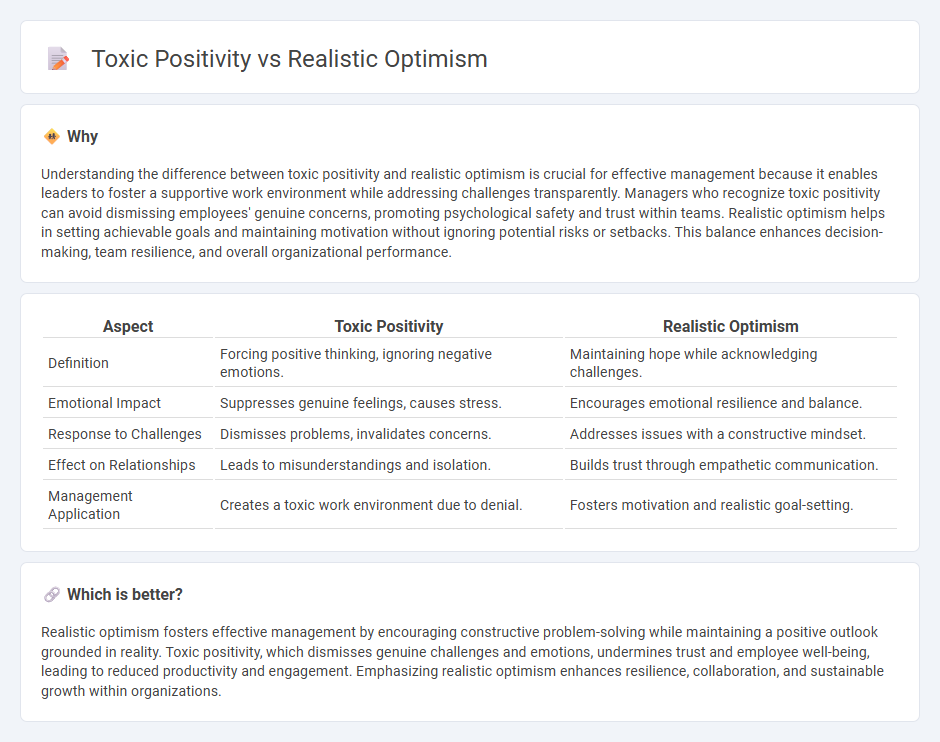
Management strategies must distinguish between toxic positivity, which dismisses valid concerns and fosters unrealistic expectations, and realistic optimism, which encourages constructive problem-solving and resilience. Understanding this balance improves team morale and decision-making effectiveness in complex business environments. Explore how to implement realistic optimism in leadership for sustainable success.
Why it is important
Understanding the difference between toxic positivity and realistic optimism is crucial for effective management because it enables leaders to foster a supportive work environment while addressing challenges transparently. Managers who recognize toxic positivity can avoid dismissing employees' genuine concerns, promoting psychological safety and trust within teams. Realistic optimism helps in setting achievable goals and maintaining motivation without ignoring potential risks or setbacks. This balance enhances decision-making, team resilience, and overall organizational performance.
Comparison Table
| Aspect | Toxic Positivity | Realistic Optimism |
|---|---|---|
| Definition | Forcing positive thinking, ignoring negative emotions. | Maintaining hope while acknowledging challenges. |
| Emotional Impact | Suppresses genuine feelings, causes stress. | Encourages emotional resilience and balance. |
| Response to Challenges | Dismisses problems, invalidates concerns. | Addresses issues with a constructive mindset. |
| Effect on Relationships | Leads to misunderstandings and isolation. | Builds trust through empathetic communication. |
| Management Application | Creates a toxic work environment due to denial. | Fosters motivation and realistic goal-setting. |
Which is better?
Realistic optimism fosters effective management by encouraging constructive problem-solving while maintaining a positive outlook grounded in reality. Toxic positivity, which dismisses genuine challenges and emotions, undermines trust and employee well-being, leading to reduced productivity and engagement. Emphasizing realistic optimism enhances resilience, collaboration, and sustainable growth within organizations.
Connection
Toxic positivity undermines effective management by dismissing valid negative emotions and challenges, leading to decreased employee motivation and engagement. Realistic optimism balances positivity with acknowledgment of difficulties, fostering a healthy work environment that encourages problem-solving and resilience. Managers applying realistic optimism create trust and promote sustainable productivity by validating experiences while maintaining forward-looking confidence.
Key Terms
Emotional Intelligence
Realistic optimism acknowledges challenges while maintaining hope, supporting emotional intelligence by fostering resilience and adaptive coping strategies. Toxic positivity dismisses genuine emotions, which can hinder emotional awareness and interpersonal empathy crucial for emotional intelligence development. Explore how balancing realistic optimism and emotional intelligence enhances mental well-being and authentic positivity.
Authentic Communication
Realistic optimism embraces genuine hope and acknowledges challenges, fostering authentic communication that validates emotions and encourages constructive problem-solving. Toxic positivity, in contrast, dismisses negative feelings and pressures individuals to maintain a falsely upbeat demeanor, undermining true emotional expression and connection. Explore how balancing these mindsets enhances meaningful dialogue and emotional resilience.
Resilience
Realistic optimism balances hopeful expectations with an awareness of challenges, fostering genuine resilience by encouraging problem-solving and emotional adaptability. Toxic positivity, however, dismisses valid emotions and hardships, undermining resilience by forcing a superficial forced positivity that can increase stress and hinder recovery. Explore the nuances between these approaches to strengthen your emotional resilience effectively.
Source and External Links
Realistic Optimism - Becoming Better - This approach combines an accurate assessment of reality with a belief in personal growth and the importance of hard work to achieve success.
Optimism is good for us as long as it's realistic - Selda Koydemir - Emphasizes the importance of balancing optimism with realism to avoid false hope and instead focus on achievable positive outcomes.
Realistic Optimism: Why Bother? - ISEI Coaching Toolkit - Describes realistic optimism as a growth mindset where individuals see challenges as opportunities for growth and success.
 dowidth.com
dowidth.com